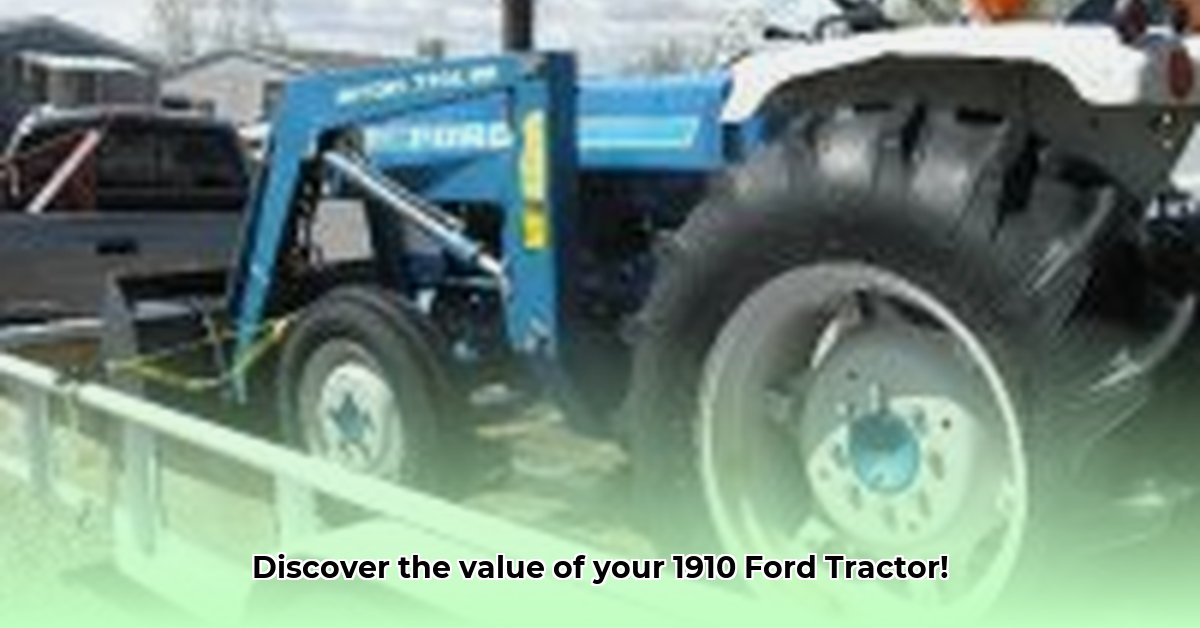
Determining the value of a vintage Ford 1910 tractor requires careful consideration of several key factors. This guide provides actionable steps for both buyers and sellers navigating this niche market. Understanding these factors will help you make informed decisions, whether you're looking to purchase a piece of history or sell your prized possession. For more in-depth valuation resources, check out this helpful guide: Ford 1910 Tractor Value.
Assessing Condition: The Cornerstone of Value
The condition of a 1910 Ford tractor significantly influences its value. A meticulously restored tractor will command a significantly higher price than one left to deteriorate outdoors. This difference can amount to thousands of dollars. Therefore, a thorough assessment is crucial.
Key Areas to Examine:
- Engine Functionality: Does the engine start and run smoothly? Are there any noticeable leaks or mechanical issues? A smoothly running engine significantly increases value.
- Transmission and Other Systems: Does the transmission shift gears smoothly? Are all components functioning as intended? Malfunctions will decrease value.
- Cosmetic Condition: Examine the tractor's paint (original or restored), the presence of rust, and the overall level of wear. A beautifully restored tractor will fetch a premium price.
- Completeness: Is the tractor complete with all its original parts? Missing or replaced parts significantly reduce value for collectors.
When selling online, high-quality and detailed photographs are essential. Showcase all aspects, including areas requiring attention. Transparency builds trust with potential buyers.
Market Research: Unveiling the True Value
Determining the precise value requires diligent market research. Don't rely on a single source; cross-reference data for a comprehensive understanding.
Effective Research Strategies:
- Online Tractor Marketplaces: Analyze recent sold prices on platforms specializing in vintage tractors. Current listings can be misleading; sold prices reflect actual market value. Websites like TractorHouse 1 are valuable resources.
- Auction Results: Review auction results from reputable classic tractor auctions. These provide insights into current market trends and prices achieved for similar tractors.
- Community Engagement: Interact with online forums and communities of Ford tractor enthusiasts. These groups offer invaluable insights and expert advice.
Remember: comparing information from multiple sources ensures a more accurate valuation.
Beyond Condition: Other Value Influencers
While condition is paramount, other factors contribute to a 1910 Ford tractor's value:
- Rarity: Certain models or features make a tractor more sought after, increasing its value.
- Originality: A tractor with mostly original parts is more desirable than one with extensive aftermarket replacements. Originality is key for collectors.
- Documentation: Original documents, including owner's manuals and registration papers, significantly enhance the tractor's authenticity and value.
Selling Your 1910 Ford Tractor: A Strategic Approach
Selling your tractor requires a structured approach to maximize its appeal and achieve the best possible price.
Proven Selling Strategies:
- High-Quality Photography: Invest in professional-quality photographs showcasing your tractor's best features. Excellent images are crucial for attracting potential buyers.
- Comprehensive Description: Craft a detailed description highlighting the tractor's condition, history, and any unique features. Be honest and transparent about any flaws.
- Strategic Pricing: Based on your research, set a competitive price that reflects the tractor's value. Avoid overpricing, as this can deter potential buyers.
- Multi-Platform Listing: List your tractor on multiple online marketplaces to reach the widest possible audience.
Patience is key. Finding the right buyer for a vintage tractor may take time.
Buying Your 1910 Ford Tractor: A Buyer's Checklist
Purchasing a vintage tractor is an exciting endeavor, but caution is essential. Avoid costly mistakes by following these steps:
Protecting Your Investment:
- Professional Inspection: Before purchasing, hire a qualified mechanic to thoroughly inspect the tractor. This prevents unexpected repair costs after purchase.
- Verify Documentation: Ensure all paperwork, including title and any historical records, is legitimate and accurate.
- Negotiate Wisely: Negotiate the price fairly and respectfully, keeping your research in mind.
- Transportation Planning: Account for the cost of transporting a heavy tractor. Factor this into your overall budget.
Careful planning minimizes risks and ensures a positive buying experience.
Online Marketplaces: A Balanced Perspective
Online marketplaces offer valuable resources for both buyers and sellers, but awareness of their limitations is vital.
| Feature | Advantages | Disadvantages |
|---|---|---|
| Accessibility | Global reach for both buyers and sellers. | Website outages and potential for inaccurate information. |
| Price Transparency | Access to sold prices provides market value insights. | Prices are highly variable, and condition assessments can be subjective. |
| Ease of Use | Generally user-friendly interfaces for listing and searching. | Risk of scams; thorough due diligence is crucial. |
By understanding the strengths and weaknesses of online platforms, you can use them effectively and safely.
Conclusion:
Valuing a 1910 Ford tractor is a multifaceted process. By combining thorough condition assessment, comprehensive market research, and careful consideration of all influencing factors, both buyers and sellers can make informed and confident decisions. The vintage tractor market is dynamic; continuous learning and staying current with market trends are essential for success.